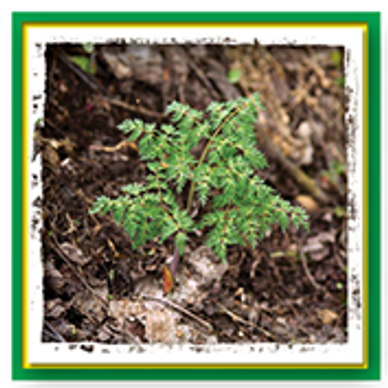Botany
Lomatium dissectum belongs to the Apiaceae family. Gardeners would recognize its umbel-shaped flowers, which resemble those of carrots, parsley, dill, and celery. Of course, there are many other non-edible species within this botanical family. Lomatium dissectum has basal leaves that are finely divided, much like those of a carrot plant. Its flowers may be red or yellow and typically stand 2 to 3 feet tall. This plant is perennial, and it is unknown how old it must be to develop its large roots, which can range from 3 to 6 inches in diameter and grow up to 2 feet long.
It grows in the semi-arid climates of the Great Basin and Northwest, particularly on steep, rocky hillsides where there is little competition from other species. While it seems to grow more prolifically in volcanic soils, it is also found in decomposed granite.
Cultivation & Harvesting
Lomatium dissectum plants make approximately 900 seeds per flower umbel each year, with several umbels per plant. The seed has a reputation as being difficult to germinate. Yet recent work has yielded up to 80% germination with fall sowing in situ, under mulch, for spring germination. In an average rainfall year, adequate moisture during the winter and spring is available for seed germination. The seedling does not tolerate transplanting. (*1)
While Lomatium in commerce is almost exclusively wildcrafted, we are working with organic herb growers who are able to put some acreage into very long-term plantings. Their 4-year-old plants are still a long way from being harvestable. The plant's adaptation to semi-arid growing regions includes summer dormancy, when soil moisture is normally inadequate for plant growth. Even when in cultivation with irrigation, this summer dormancy programming is maintained. Thus, plants grow slowly from year to year. There is an appropriate concern about overharvesting any medicinal herb that is primarily obtained by wildcrafting. It is not considered endangered at the moment, although it is being closely watched. We are therefore very careful to purchase our Lomatium dissectum root extract from a single supplier whose harvesting methods are respectful to the native habitat. Sometimes traveling to remote areas, we take only a small percentage of the plant from any particular area so that their harvesting makes the least possible impact, aiming for sustainability of the wild growing areas. (*2)
*Note: The cultivation method above was discontinued due to poor long-term results, so now we only carry wildcraft.





MTN.Oaks, LLC | mtn.oaks@frontiernet.net
P.O. Box 155, Doyle, CA 96109
Call 1 (775) 437-2711 (PST) or 1 (530) 827-3380)
Copyright © 2025, MTN.Oaks, LLC. All Rights Reserved.
Powered by GoDaddy
This website uses cookies.
We use cookies to analyze website traffic and optimize your website experience. By accepting our use of cookies, your data will be aggregated with all other user data.